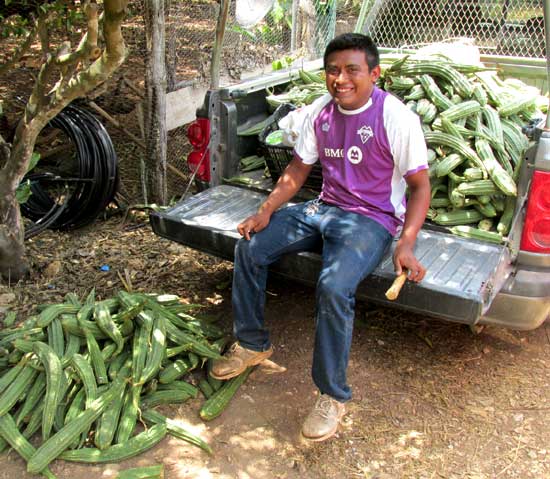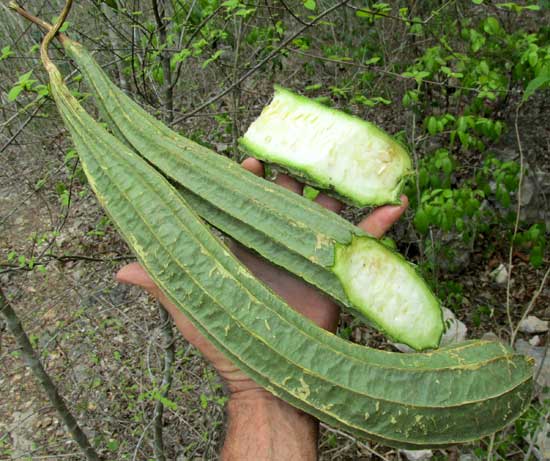Excerpts from Jim Conrad's
Naturalist Newsletter
from the May 14, 2017 Newsletter issued from Rancho Regenesis in the woods ±4kms west of Ek Balam Ruins; elevation ~40m (~130 ft), N20.876°, W88.170°; north-central Yucatán, MÉXICO
CHINESE OKRA
At the rancho this week a pickup truck backed up beneath a Sour Orange tree and my Maya friend Gener began unloading a load of one of the most unusual fruits I've seen lately. Below, you can see Gener interrupted during his work:

A local farmer growing a crop commercially for the human food market had given these to us, to feed to the livestock, because they'd grown too large, hard and bitter to sell. Below, you can see some fruits, with one cut open showing what's inside:

The farmer told us that it was Okra, using that English name, but of course it's not the Okra/Gumbo North Americans know about. That Okra is a member of the Hibiscus Family, which you can believe if you've paid attention to Okra flowers. This fruit looked like it had dangled from a vine, and the cut-open fruit smelled and looked cucumbery, so I figured it was a viny member of the Squash/Pumpkin/Gourd/Cucumber Family, the Cucurbitaceae.
Along a street in Río Lagartos on the Yucatan's northern coast, a while back we ran into Luffa Gourd, Luffa cylindrica, whose well illustrated page is at www.backyardnature.net/yucatan/luffa.htm
This week's mystery fruits looked a bit like that Luffa, so that's where I began my sleuthing trying to figure out what it was. It didn't take long before my dogeared Bailey's Manual of Horticultural Plants informed me that at least two species of the genus Luffa are widely planted in the tropics, and the description of the species I'd not seen fit exactly what's shown in our photos, and later the Internet confirmed the ID.
This vine originally from eastern Asia is cultivated in so many countries that it goes by numerous common names, including Chinese Okra, Angled Luffa, Dish Cloth Gourd, Ridged Gourd, Sponge Gourd, Vegetable Gourd, Strainer Vine, Ribbed Loofah, Silky Gourd, Ridged Gourd, and Towelsponge. It's LUFFA ACUTANGULA.
You can guess from some of its common names that, like our earlier Luffa cylindrica in Río Lagartos, Chinese Okra's mature fruits contain fiber that when dried and cleaned can be used like a washrag. Among medicinal uses mentioned by the "Useful Tropical Plants" website is its fruits and seeds being employed against venereal diseases, extracts from its leaves serving against guinea worms, and its leaf sap being used against eczema, and as an eyewash to treat conjunctivitis.
The literature says that numerous cultivars have been developed from Luffa acutangula, with some used mainly for the tough fibers producing fruits too bitter to eat, even toxic, while other cultivars produce tasty fruits. Fruits for eating should best be picked when only about 10cm long (4inches), I read.
We want to plant this Luffa species at the ranch, but all the fruits in the pickup truck were too young to provide mature seeds, and I read that well mature seeds are needed for planting.
So, here's yet another world-famous and very useful plant that I've managed to remain ignorant of for nearly 70 years.